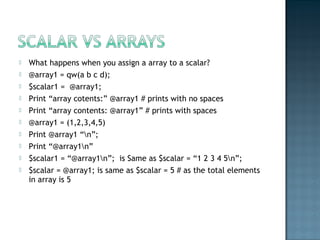Introduction to perl_control structures
- 1. DAY 4: Control Structures Vamshi Krishna .S
- 2. A statement block is a sequence of statements, enclosed in matching curly braces. It looks like this: { first_statement; second_statement; third_statement; ... last_statement; # last statement semicolon is optional. }
- 3. print "how old are you? "; $a = <STDIN>; chomp($a); if ($a < 18) { print "So, you're not old enough to vote, eh?n"; } else { print "Old enough! Cool! So go vote!n"; $voter++; # count the voters for later }
- 4. print "how old are you? "; $a = <STDIN>; chomp($a); unless ($a < 18) { print "Old enough! Cool! So go vote!n"; $voter++;
- 8. Arrays are a special type of variable that store list style data types. Each object of the list is termed an element and elements can either be a string, a number, or any type of scalar data including another variable. Array variables have the same format as scalar variables except that they are prefixed by an @ symbol. Arrays can also hold arrays.
- 9. array variable is a variable which is a list of scalars (ie numbers and strings). Array variables have the same format as scalar variables except that they are prefixed by an @ symbol. @var = (value1..valueN); @var = (“str1”,”str2”) ($a, $b) = @alphabets; # $a and $b are the first two elements of @alphabets array #!/usr/bin/perl main(@ARGV); my $days =qw^Sun Mon Tue Wed Thu Fri Sat^; Print @days; My $days=31; Print $days; # It is valid to use the same name for scalars and array types.
- 10. My @array1 =(1,2,3); My @array2 = (@array1 ,4,5,6); Print “@array2”; # prints 1 2 3 4 5 6 Print $array2[2]; # prints 3 Print scalar @array2 # Here the scalar will contain the value 6 , as the total no’of elements in the array2 is equal to 6
- 11. #!/usr/bin/perl use warnings; use strict; say “input a number”;# functionality same as “print” , adds a new line character at the end My chomp($choice =<STDIN>); print qw(BMW Ferrari McLaren Jaguar ) [$choice]); OUTPUT:- McLaren
- 12. If you input a decimal value .. Choice = 1.2 then perl will round if off and will output Ferrari. If you input a negative number.. Choice = -1 then perl starts counting backwards from the end of the list. LIST Slices instead of putting a scalar value [$choice].. We can also print out multiple values in the list by putting a list of index values (20,30,99,15,22,13,56,76,34)[2,5,7] This can also be used on strings.
- 13. What happens when you assign a array to a scalar? @array1 = qw(a b c d); $scalar1 = @array1; Print “array cotents:” @array1 # prints with no spaces Print “array contents: @array1” # prints with spaces @array1 = (1,2,3,4,5) Print @array1 “n”; Print “@array1n” $scalar1 = “@array1n”; is Same as $scalar = “1 2 3 4 5n”; $scalar = @array1; is same as $scalar = 5 # as the total elements in array is 5
- 14. (1 .. 10) ( -9 .. 9) (a .. z) Cant mix up the list of elements list .. (a .. 5) or (-1 .. B) etc., Always the right-hand element should be higher than the left-handed element. We can mix up the Slices and ranges.. For effective programming @coins = qw(Quarter Dime Nickel Penny); @slicecoins = @coins[0,2]; Say "@slicecoins"; # prints 0th index value “Quarter” and 2nd value “Nickel” with Spaces b/w strings.
- 15. $a = (@array)[3]; My @array1= Print $array1[1]
- 16. @lang = qw(java python perl c); My $element;# declating scalar var for iteration For $element (@lang) { print $element “n”; } For <iterator> (<list of array>) BLOCK If we don’t supply an iterator of our own.. Perl supplies a special variable S_ which is often used in perl functins as default value @array1 = (1,2,3,4); Print “before @array1 n” For (@array1) {$_ * = 10} Print “after @array1n”
- 17. #!/usr/bin/perl my @coins = ("Quarter","Dime","Nickel"); # ADD ELEMENTS push(@coins, "Penny"); print "@coins"; print "<br />"; unshift(@coins, "Dollar"); print "@coins"; # REMOVE ELEMENTS pop(@coins); print "@coins"; shift(@coins); Adding elements is a breeze, we use the following functions to add/remove and elements: push() - adds an element to the end of an array. unshift() - adds an element to the beginning of an array. pop() - removes the last element of an array. shift() - removes the first element of an array.









![ My @array1 =(1,2,3);
My @array2 = (@array1 ,4,5,6);
Print “@array2”; # prints 1 2 3 4 5 6
Print $array2[2]; # prints 3
Print scalar @array2
# Here the scalar will contain the value 6 , as
the total no’of elements in the array2 is
equal to 6](https://image.slidesharecdn.com/introductiontoperlcontrolstructures-130721094945-phpapp01/85/Introduction-to-perl_control-structures-10-320.jpg)
![#!/usr/bin/perl
use warnings;
use strict;
say “input a number”;# functionality same as
“print” , adds a new line character at the end
My chomp($choice =<STDIN>);
print qw(BMW Ferrari McLaren Jaguar )
[$choice]);
OUTPUT:- McLaren](https://image.slidesharecdn.com/introductiontoperlcontrolstructures-130721094945-phpapp01/85/Introduction-to-perl_control-structures-11-320.jpg)
![ If you input a decimal value .. Choice = 1.2 then perl will
round if off and will output Ferrari.
If you input a negative number.. Choice = -1 then perl
starts counting backwards from the end of the list.
LIST Slices
instead of putting a scalar value [$choice].. We can also
print out multiple values in the list by putting a list of
index values
(20,30,99,15,22,13,56,76,34)[2,5,7]
This can also be used on strings.](https://image.slidesharecdn.com/introductiontoperlcontrolstructures-130721094945-phpapp01/85/Introduction-to-perl_control-structures-12-320.jpg)

![ (1 .. 10)
( -9 .. 9)
(a .. z)
Cant mix up the list of elements list .. (a .. 5) or (-1 .. B) etc.,
Always the right-hand element should be higher than the left-handed
element.
We can mix up the Slices and ranges.. For effective programming
@coins = qw(Quarter Dime Nickel Penny);
@slicecoins = @coins[0,2];
Say "@slicecoins"; # prints 0th
index value “Quarter” and 2nd
value “Nickel”
with Spaces b/w strings.](https://image.slidesharecdn.com/introductiontoperlcontrolstructures-130721094945-phpapp01/85/Introduction-to-perl_control-structures-14-320.jpg)
![ $a = (@array)[3];
My @array1=
Print $array1[1]](https://image.slidesharecdn.com/introductiontoperlcontrolstructures-130721094945-phpapp01/85/Introduction-to-perl_control-structures-15-320.jpg)

